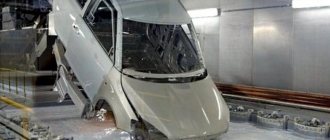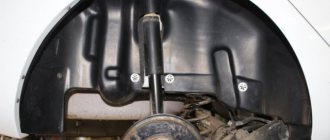Prestige and body
The Czech brand Skoda has always been rated quite highly on the market, and even more so after coming under the wing of Volkswagen Konzern.
After all, since then it has offered true German quality, but the price remains slightly lower in comparison with Volkswagen and Audi models. A sort of “German with a Czech passport.” In Russia, the Skoda brand has always been popularly loved, which only adds points to Rapid. Who will be the best - Lada or Skoda?
In terms of bodywork, it's still a draw - on the Skoda side there is only a liftback, and the Lada is limited to a sedan. However, over time, everything will change when Vesta, made in variations of a carriage and a hatchback, appears in service. And the proposed modifications of Cross and Signature will leave the Czech no chance at all.
In terms of its size, Lada Vesta is recognized as one of the leaders in the B segment.
— length – 4,410 mm and 4,483 mm;
— width – 1,764 mm and 1,706 mm;
— height – 1,497 mm versus 1,474 mm;
— ground clearance – 178 mm versus 170 mm for Rapid;
- trunk volume - 480 liters versus 530 liters;
— weight – 1,230 kg (1,670 kg) versus 1,150 kg (1,722 kg).
However, it cannot be said that Skoda is too far behind the “Russian”.
As you can see, the models are noticeably equal. The Rapid is longer, but the Vesta is wider and taller, the difference in ground clearance is not the most noticeable, but the wheelbase of the Russian sedan is noticeably longer - 2,635 mm versus 2,602 mm. However, when comparing trunks, the Rapid turns out to be unattainable - when unfolded, its volume reaches 1,470 liters!
When comparing trunks, Rapid blows away!
Options and cost
But after reading the price tag, the difference between the LADA Vesta and Skoda Rapid becomes clear. And it's a big one. Thus, the starting price for Vesta starts from 514,00 rubles, and for Rapid – from 569,000 rubles. And at the top the situation is completely depressing - 658,000 rubles. for Vesta and as much as 926,000 rubles. for Rapid! The difference is simply huge - 268,000 rubles!
In addition, it is necessary to remember the difference in approach to configurations. Skoda Rapid has only three of them. But each version can be equipped with a number of options for an additional fee. The owner of a Lada Vesta is deprived of this opportunity, but the presence of 6 modifications more than compensates for this.
Exterior
Here it is absolutely inappropriate to compare the exteriors of the two models; the design concept in them is fundamentally different.
The lines of the Lada Vesta are made in a dynamic design, body elements are emphasized by original design techniques. It should be noted that these techniques have not previously been used in models.
The appearance of the Skoda Rapid is made in the usual European austerity. For the most part, the exterior of the Skoda can be classified as a classic. But a small part of modern solutions has been added that give the model a sporty touch. This is the design of the front bumper with a lattice insert and a unique design of the wheel rims.
The dimensions
of the Skoda Rapid are longer than the Lada Vesta. But Vesta has a different preference - in height and wheelbase. Vesta's ground clearance is greater than that of Skoda, which is an excellent solution for Russian roads with their unfavorable conditions. The length and width dimensions of both models ensure easy maneuverability of the vehicle on road sections saturated with vehicles.
A detailed comparison allows you to analyze and compare dimensions more broadly:
- Body length - 448.3 cm (Skoda Rapid), 441.0 cm (Lada Vesta);
- Body width – 170.6 cm (Skoda Rapid), 176.4 cm (Lada Vesta);
- Car height – 147.4 cm (Skoda Rapid), 149.7 cm (Lada Vesta);
- Ground clearance - 17 cm (Skoda Rapid), 17.1 cm (Lada Vesta);
- Wheelbase - 260.2 cm (Skoda Rapid), 257.0 cm (Lada Vesta);
- Luggage compartment volume – 530 l (Skoda Rapid), 480 l (Lada Vesta).
Externally, there are completely different approaches to design. AvtoVAZ followed the path of an aggressive and cocky style. The chrome strips in the front of Vesta emphasize the grin of the faceted headlights and radiator grille, which turns into a massive air intake. Round foglights complete the look.
Just a few years ago no one would have thought of such an appearance for Lad.
From the side, Lada looks no less impressive. Of course, some believe that the signature X-shaped understamping makes the car look less long, which is enhanced by the impression of large wheel arches and high ground clearance, but overall the design from Steve Mattin and his team is impressive. Muscular shapes, stylish rims, wedge-shaped profile do their job.
From the side, Vesta may seem short, but this is a visual deception.
And the food was frankly a success. Massive, but not heavy, it harmoniously completes the composition of the car. The feet, with their chopped outlines, combine well with the chrome on the trunk lid and the powerful bumper.
Vesta's stern just seems too massive. In fact, everything is great!
The Skoda Rapid, made in the corporate style of Volkswagen, looks different. Here there is extreme precision and, at times, even outright pedantry of the creators. But this only emphasizes becoming a car.
Smooth lines, traditional grille louvers, contoured optics and huge, rectangular fog lights located on the sides of the air intake are in perfect harmony.
The German corporate style has not bypassed the Skoda Rapid.
Thread gaps between parts, straight lines of doors and wings, branded rims. Indeed, the “little brother” of the Octavia A7 fills the motto with special meaning. Rapid is a vivid example when simplicity can be the most advantageous option.
From the side of the "Czech" you won't immediately recognize the liftback.
The same applies to the rear, with its almost square lights, large bumper and sharp transitions of the luggage compartment lid, decorated with branded emblems and nameplates.
From behind the car looks no less advantageous.
“They meet you by their clothes...”: interior and exterior of competitors
Conservatism and a certain simplicity versus dynamics and new design: this is how the exterior solutions of both cars can be characterized.
Vesta entered the car market with a confident look: aggressive forms, sharp edges of both the body and the component parts: headlights, radiator grille, all this lets all critics know that Vesta is ready for battle. The original design work of a professional is finally visible behind almost every detail of the car - the sedan turned out to be impressive, noticeable and stylish.
All this plays into its hands: the strict outline gives the car an official appearance, which is difficult to recognize as a liftback.
In terms of size, the advantage passes from model to model: if Rapid takes the cake with its length, then in the matter of width, height and ground clearance, “pure victory” is in the hands of Lada:
- length: 4483 mm compared to 4410;
- width: 1764 and 1706 mm;
- height: 1497 versus 1474 mm;
- and a ground clearance of 178 mm for Vesta and 170 mm for Rapid, respectively.
An important point for our car enthusiasts is the trunk volume, where the Czech version clearly has an advantage: 530 liters. versus 480 liters, but if we take into account the possibility of folding the rear seats, then the value of the useful volume increases almost 2 times.
The “inner world” of both cars: the design of the seats, dashboard and other parts of the car fully corresponds to their appearance. The style of the Lada Vesta is still rich in novelty:
- model chairs, upholstered with high-quality and pleasant-to-touch material, as well as with excellent fixation on the sides;
- prominent instrument panel and center console with ergonomically located panels and buttons;
- Convenience for rear passengers provides sufficient space for three people - in this matter, the designers' obvious concern for a comfortable stay on the rear sofa is visible.
Salon
The next factor that can influence the decision in choosing a four-wheeled friend is the interior.
The design and interior of the Skoda Rapid salon is made in a classic style. The front panel has a straightforward design solution - nothing superfluous.
Lada Vesta is designed more futuristically in this regard. The alternation of smooth combinations and lines, the presence of a variety of devices to ensure full functionality, gives the impression of a more sophisticated and modern design.
Along with all the advantages, the Skoda Rapid is not without its disadvantages:
- The inconvenience of landing is due to the small doorway;
- The driver's seat is equipped with an armrest, access to the handbrake is limited;
- Small accelerator pedal travel;
- Insufficient ceiling height - not comfortable for tall passengers;
- The rear window is tilted at too great an angle;
- There is no lock on the gas tank.
Lada Vesta also has its own disadvantages:
- The front panel is made of hard plastic;
- The location of the gas and brake pedals is not very good (there is a small distance between the pedals);
- The rear doors are equipped with glass that does not open completely.
The Skoda Rapid is available with six possible engine versions, the Lada Vesta has three possible options.
The maximum acceleration of the Lada Vesta is up to 187 km/h, the Skoda Rapid can accelerate to
km/h This suggests that the Lada Vesta is a more economical option for its owner in terms of fuel consumption. We compared the Lada Vesta and Skoda Rapid, but this is not the only competitor of the Russian new product. Want to know more? Check out our material Who will win: Lada Vesta or Renault Logan 2?
Basics: characteristics of the “insides” of Vesta and Rapid
Fairness in assessment is achieved by comparing both external and internal features. Let's look at engines and gearboxes.
Vesta offers a 1.6-liter engine with a power of 106 hp. The fuel consumption of this engine is higher compared to the Rapid versions: 9.3/6.9/5.5 liters in different driving modes. Also, future versions delivered for the fall of 2020 include two engines: a Nissan version with an engine capacity of 1.6 liters. and a power of 110 hp, as well as a new domestic model with a power of 122 horsepower and increased to 1.8 liters. engine volume. The base is 1.6 l. petrol engine 87 hp
Skoda still beats in this comparison by a decent margin: the minimum option is 1.6 liters. with a power of up to 90 hp, the most powerful engine is the turbocharged model with 125 hp. and engine capacity of 1.4 liters.
In terms of transmission, Lada introduced a manual 5-speed manual transmission and a robotic AMT also with 5 steps. In this regard, Rapid offers variety depending on the configuration: from a five-speed manual to 6 and 7 speed. Automatic transmission.
In this aspect, a certain advantage goes to Skoda: a high-quality transmission and more (albeit slightly) powerful engines tip the scales in their favor.
Specifications
Engines
The engine range of the Czech liftback is much wider, because it can offer customers a trio of engines, versus only one in the Lada Vesta.
The Skoda Rapid line begins with an in-line, 1.6-liter naturally aspirated engine with an injection power system. This 16-valve engine produces 90 hp. With. at around 4,250 rpm, and already at 3,800 rpm the owner has a peak thrust of 155 Nm. Despite the low power, acceleration with it is quite brisk - a hundred on the speedometer is achieved in 11.4 seconds, with a maximum speed of 185 km/h. And the consumption is impressive - 7.8/5.8/4.6 liters.
The 90-horsepower engine of the Skoda Rapid, although rather weak, accelerates very well!
The second was an engine of the same design and volume, but with a power of 110 hp. With. However, for a significant increase in l. With. had to pay a much higher peak when they are reached - it has shifted to a figure of 5,800 rpm. The torque has not changed, as well as its mark – 155 Nm at 3,800 rpm.
The 110-horsepower engine is very similar to its “younger brother”.
LADA Vesta can oppose it with its own, domestically produced 1.6-liter engine with a capacity of 106 hp. With. All of them are achievable at 5,800 rpm, while 148 Nm of torque are available at 4,800 rpm. It is worth recognizing that technically it is not so perfect. This is evidenced by both dynamic characteristics and appetite. Acceleration to 100 km/h takes 11.8 seconds. (12.8 seconds with AMT), but you have to pay for this with a consumption of 9.3/6.9/5.5 liters.
The Lada Vesta engine, although inferior to the 110-horsepower one of the Rapid, has already managed to show its best side.
The latest engine is a turbocharged unit from Skoda Rapid - a 1.4-liter TSI engine with direct fuel injection. Its power reaches 125 hp. With. at 5,000 rpm, and a huge torque of 200 Nm is available in the widest range of 1,400 to 4,000 rpm. With such an engine, Rapid is simply beyond competition, because its acceleration takes only 9 seconds.
With a TSI engine and a turbine, Skoda turns into a rocket!
Soon, other engines will appear under the hood of the Lada Vesta - an 87-horsepower 8-valve engine, which will become a competitor to the Skoda engine (90 hp), and a 110-horsepower unit from Renault-Nissan. With the latter, Vesta will compete on equal terms with Rapid, which is similar in power. But the counterpart of the Czech turbo engine is the new AvtoVAZ engine - a 1.8-liter, 122-horsepower unit. But all of them will appear later - no earlier than autumn 2020.
The remaining engines, including the 122-horsepower one, will appear under the hood of the Russian sedan later.
Transmissions
In this regard, the victory for the Skoda Rapid is complete. In terms of manual transmissions, the situation is equal - both Rapid and Vesta offer 5-speed gearboxes, and the Lada can be bought with both domestic and French manual transmissions. As for the clarity of operation and quality of all transmissions, there are no complaints about them.
Unlike other AvtoVAZ models, Lada Vesta owners have no complaints about the manual transmission.
But in terms of automatic transmissions, Skoda’s advantage is complete. Lada Vesta is equipped with a 5-band AMT type robot, created on the basis of a manual gearbox. In general, it is sufficient for driving both in the city and on the highway, although it clearly lacks the smoothness of a classic automatic transmission. But AMT is cheaper and less burdensome to maintain.
With AMT, driving in Lada Vesta is more convenient and easier, especially in traffic jams.
The choice of Skoda specialists fell on a traditional, 5-range torque converter. It works flawlessly - clearly, logically and silently. Gears are switched quickly, the same applies to the kick-down command. And for the 1.4-liter turbo engine there is a preselective DSG transmission with 2 clutches. It has excellent technical performance, but is expensive and complex.
The DSG transmission in the B segment is an extraordinary phenomenon.
It is noteworthy that even in the 1.4 TSI versions with DSG, the Czechs did not use a multi-link suspension, limiting themselves to a simple torsion beam on the rear axle and MacPherson struts on the front. A similar scheme is used on the Lada Vesta.
The chassis design of both Skoda and Lada is similar.
Overall, both cars handle very well. Rapid is traditionally dense, which manifests itself in slightly less roll in corners, but also affects comfort. In this case, it’s time to say that both models are approximately equivalent.
Why is Skoda better?
The Lada Vesta sedan is still growing and growing before the Skoda Rapid... Many parameters of the Skoda will be better, even if you compare the basic versions.
| Parameter | Skoda | Lada |
| Metal thickness | More | Less |
| Curb weight, kg | 1150 | 1230 |
| Torque, N*m | 155 (3800 rpm) | 148 (4200 rpm) |
| Acceleration to hundreds, s | 11,4 | 11,8 |
| Fuel consumption per 100 km, l | 5,8 | 6,9 |
| Compression ratio (1.6 L) | 10,5 | 11,0 |
We recommend: The best compact crossovers: review of car models
It seems that gasoline with a lower octane number is suitable for the Skoda engine than for the VAZ-21127 engine... It is recommended, however, to only pour AI-95.
If 90 horsepower does not seem enough, you can buy a liftback with a 110-horsepower engine. True, for this you will have to pay 706 thousand, not 574.
AvtoVAZ still has two absolute advantages: low price and affordable maintenance costs. It needs to be carried out every 15 thousand km.
Dimensions of the Vesta sedan
Dimensions of Skoda Rapid
The external dimensions and interior volume of the two cars under consideration differ little. But the center of mass of the liftback is moved back. The bulky feed and reduced wheelbase are an argument in favor of poor cornering stability. That’s right: Vesta must be no worse in some ways!
The trunk volume of the Skoda Rapid is 530 liters. If you fold down the rear seats, it increases. Lada Vesta loses here - its value is 480 hp. But if the Rapid's trunk is properly loaded, the car goes into a skid when cornering.
Why are the disks different?
In the basic version, Rapid liftbacks are stamped 5J x 14 ET35 . For Vesta, there are 15-inch and 16-inch wheels. This all looks somehow uneconomical. Just for the basic configuration, they buy tires from Belarus - they supply tires with a diameter of 15 inches.
Belshina cast tires 15''
Interior
Here the approach is the same as in the case of appearance. The LADA Vesta interior is designed in a new style. A dashboard with spectacular wells, a grippy 3-spoke steering wheel, a protruding center console with a large screen and thoughtful ergonomics. All this, coupled with new seats with high-quality lateral support and good visibility, is in sharp contrast with other AvtoVAZ products.
Lada Vesta is the case when the interior completely matches the exterior.
The back row of the Lada Vesta is free and comfortable. Three headrests allow room for three passengers, and the width of the car guarantees shoulder room. And your legs don’t rest on the front seats. In a word, the designers did a truly amazing job on the interior of the Lada Vesta!
The rear of the Lada is also not inferior - comfortable, high-quality and spacious!
The Rapid's salon is different. In him, as in his appearance, correctness and German character shine through. In fact, the only thing missing for a complete ambiance is a table lamp - with it you could feel like you’re in an office.
Definitely, the Rapid salon is an example to follow!
The driver's seat is organized extremely competently. A standard readable dashboard, straight lines in the dashboard, a very comfortable steering wheel, a good combination of colors in the decoration and an arrangement of controls that allows you to use everything with your eyes closed - that’s what the Rapid’s interior is all about. And, most importantly, all this “correctness” is not devoid of aristocracy and taste!
Looking for flaws in all this splendor is a thankless task.
Price for Lada Vesta and Skoda Rapid
At the moment, there are 6 different configurations of the Lada available for sale with a price range from 514 to 633 thousand rubles. The Skoda trim level is poorer, but at the same time it is more “biting” in terms of cost: only 3 trim levels with a large jump in prices, ranging from 569 to 860 thousand rubles.
Assessing the basic configuration of the models: Lada Vesta Classic and Skoda Rapid Active, the advantage both in price and in the list of built-in equipment, again, is on the side of Lada:
- 2 airbags instead of one;
- air conditioner included;
- 15-inch wheels versus 14 inches;
- Lada's available hill start assistance system and ERA-GLONASS system;
- Vesta has rear fog lights;
- electric lift of all windows, as well as electric drive for mirrors, including their heating.
Rapid, in turn, in the basic configuration comes out ahead thanks to the built-in audio system with 4 speakers, while Vesta is limited to audio preparation. Skoda also benefits from the presence of rear disc brakes, while Lada is limited to drum brakes. As a result, we get a slight, but still, advantage of Vesta both in terms of cost and functionality over its Czech rival.
Drive and gearbox
Today's competitors are exclusively front-wheel drive and can be equipped with manual or automatic transmission. There are no complaints about manual variable gearboxes (the exception is the “inherited” howl of the Russian-made VAZ manual transmission on Lada). If “mechanics” is not given to you, with all confidence, buy only a “Czech”. The Vesta's robotic gearbox cannot be compared with the DSG type transmission offered by VAG specifically for the 1.4 liter turbo engine. If the client prefers a “classic” gearbox, Skoda has provided this option by offering a 5-speed torque converter. Gears change quickly, so you don’t have to ride behind everyone else in traffic.
↑ Appearance
When it comes to the design of the Lada Vesta and Skoda Rapid, comparison is extremely difficult, since these cars were created in accordance with completely different concepts.
Like the upgraded Skoda Octavia, which was replaced by the Rapid, the Czech liftback has the appearance of a classic European business car. Clear, precise lines, a strict silhouette, restraint and sometimes even German pedantry - these are the characteristic features of Rapid. He is very similar to a bank clerk: modest, inconspicuous, but always stylish, business-like and looking respectable enough not to get lost even among top managers.
The car’s belonging to a Czech brand is unmistakably obvious, first of all, thanks to the characteristic signature radiator grille and the famous winged arrow on the hood. It is worth noting that the influence of the German school of design is also felt in the appearance of the car; there is a fairly clear similarity with modern Volkswagen models. Therefore, those who want to order an advertisement from Farpost Design for some product that should be associated with real quality can easily use a comparison with Rapid.
The exterior of AvtoVAZ’s brainchild is radically different from its Czech competitor: if the Skoda Rapid is restraint, precision, calm and poise, then the Lada Vesta is expression, cockiness, drive, assertiveness and even aggression. The evil grin of the radiator grille, powerful air intakes, wolf-like headlights, and sculpted hood – these are the characteristic features of Vesta’s appearance. At the same time, the car looks aggressive not only from the front, but also from the side, where the signature deep X-shaped stamping that has become a signature catches the eye first. This design, together with wide wheel arches and a fairly high ground clearance, makes the VAZ sedan visually significantly shorter than the Skoda liftback, although in reality the difference is only 7 centimeters.
The difference in approaches to vehicle design is visible in literally every detail. For example, the wheels of the cars are also different: while the Czechs install modest 14-inch ones, the Russians already offer customers 15-inch wheels in the database, and if desired, you can also get 16-inch ones.
In general, Lada Vesta has become, perhaps, the first production model, the appearance of which evokes significantly more positive emotions than negative ones. However, if we talk about solidity and prestige, then Rapid definitely wins in this component.
When comparing Rapid and Lada Vesta, it is worth mentioning the presence of both models in a station wagon. VAZ's Vesta SW is superior to Skoda's Spaceback in size (the difference in length is as much as 10 centimeters) and looks somewhat heavy, resembling not even a station wagon, but a small minivan. Spaceback looks very collected and dynamic; in appearance, the car can more likely be classified as a youth car than a family car.











